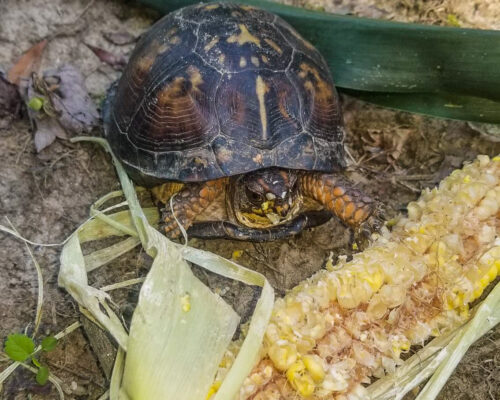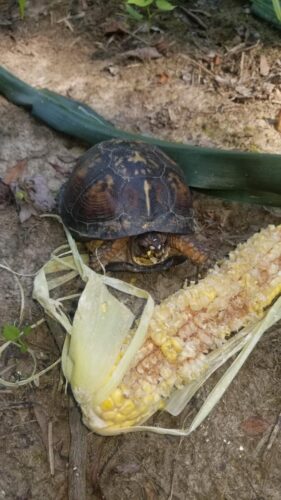Does Every Picture Tell a Story?
October 13, 2022 10:52 am

By Scott Bachman, Area Forester

The guilty party? (Photo by Eric Brittle, DWR)
This summer, my colleague Evan Richardson was asked by a landowner to prepare a Forest Stewardship Plan on a newly acquired property in southern Suffolk. One of his concerns was the management of a pond on the property. As foresters, our expertise is in trees and forests. Our officemates at the Portsmouth Office, however, work for Virginia’s Department of Wildlife Resources (DWR). The relationship we have created with this agency makes it easy to reach out to these resource professionals for help. So, to assist us with questions about pond management, local DWR fisheries biologist Eric Brittle joined Evan and me in the field.
We met on the tract and walked the edge of a cornfield to reach the earthworks of the pond. On the way around the pond, we noticed a good bit of the corn had been knocked down. Suddenly we came upon what could have been the culprit, still in the field feeding on the downed corn.
We couldn’t believe our eyes! Had this Eastern box turtle knocked over the stalks to feed on the fresh young corn? The evidence was all over its snout! Maybe Suffolk really does have Teenage Mutant Ninja Turtles.
Obviously, this photo does not tell the entire story of the downed corn in the field. After we had a good laugh about ninja turtles, and maybe asking for a crop damage permit for turtles, we came to our senses. A box turtle is certainly not able to pull down a corn plant to feed on the juicy ears. Something else had to have caused the corn to fall.
As we continued walking, we came across some footprints in the mud. The tracks were from at least one black bear. Perhaps the bears were the more probable candidate for the crop damage, and the turtle was simply taking advantage of a resource made available to it? That explanation seemed much more likely.
What does this story have to do with forestry? It provides an important reminder about any investigation. DOF field foresters and technicians are trained to investigate forest fires, tree health problems, and water quality issues on harvest operations.

The more likely culprit left evidence. (Photo by Scott Bachman)
We must remember not to allow preconceived ideas or snap judgements to cloud our investigation. A dead tree may have large holes, but did an insect borer or woodpecker seeking out the insects really cause the mortality? If we notice sediment in a water course, was it the result of harvest operations, or is something further upstream causing the sedimentation?
The encounter with the turtle was a good reminder not to jump immediately to a conclusion based on what you first see. There can be many different possibilities, and it is our responsibility to eliminate what we can and develop the evidence that we have to determine the true cause.
So, while a picture may be worth a thousand words, it doesn’t always tell the whole story.
Tags: What's in the Woods Today
Category: Education
